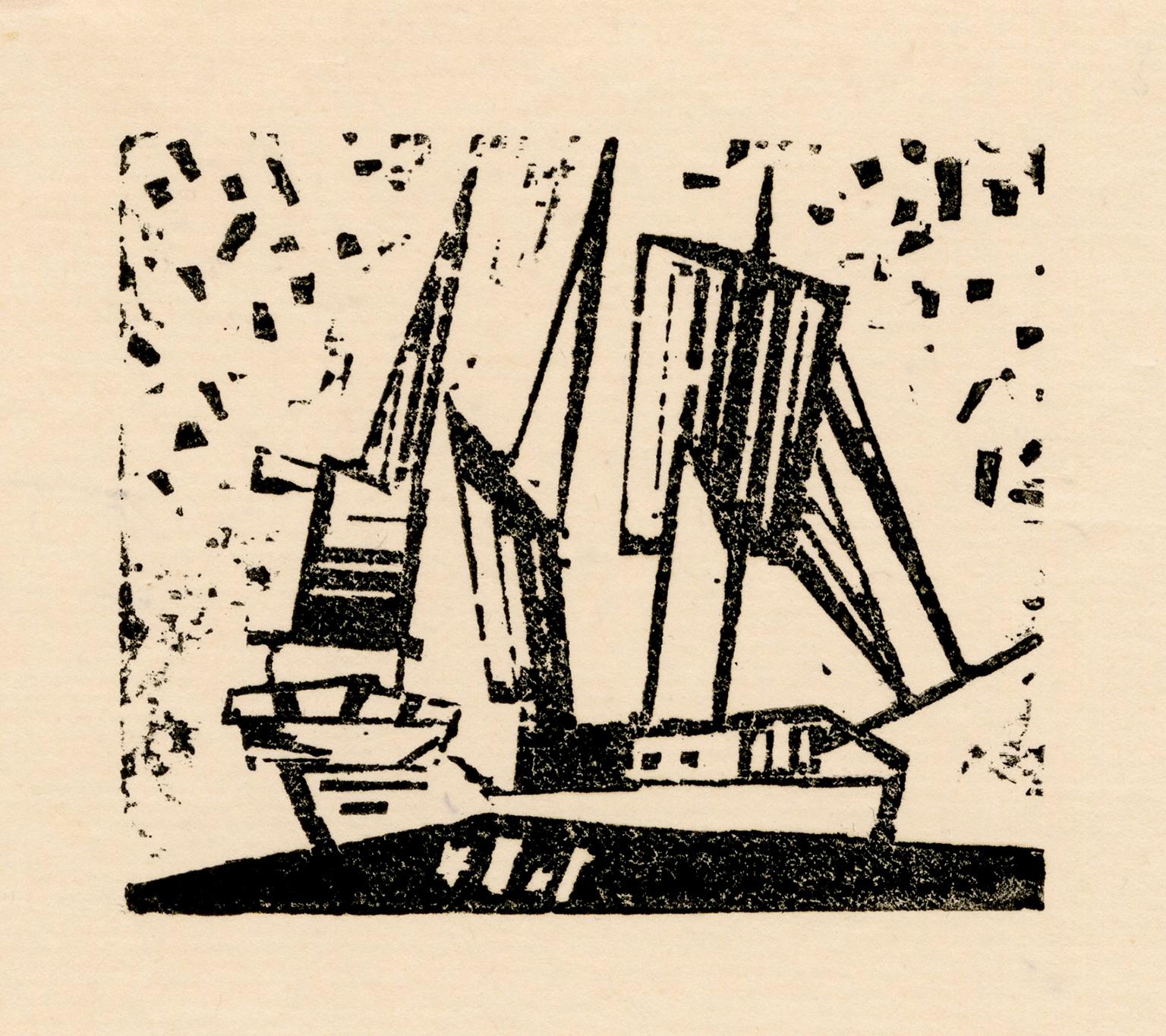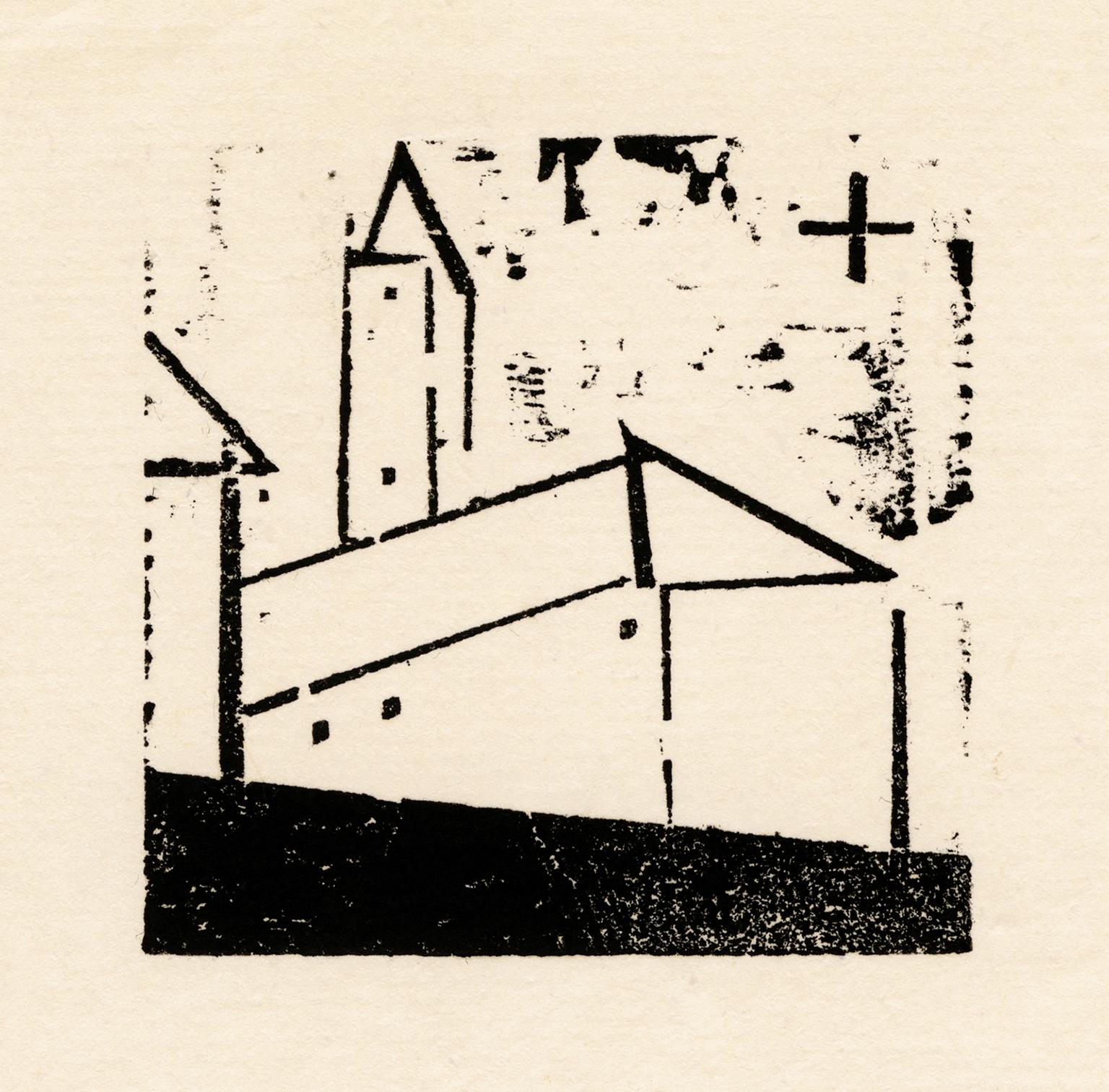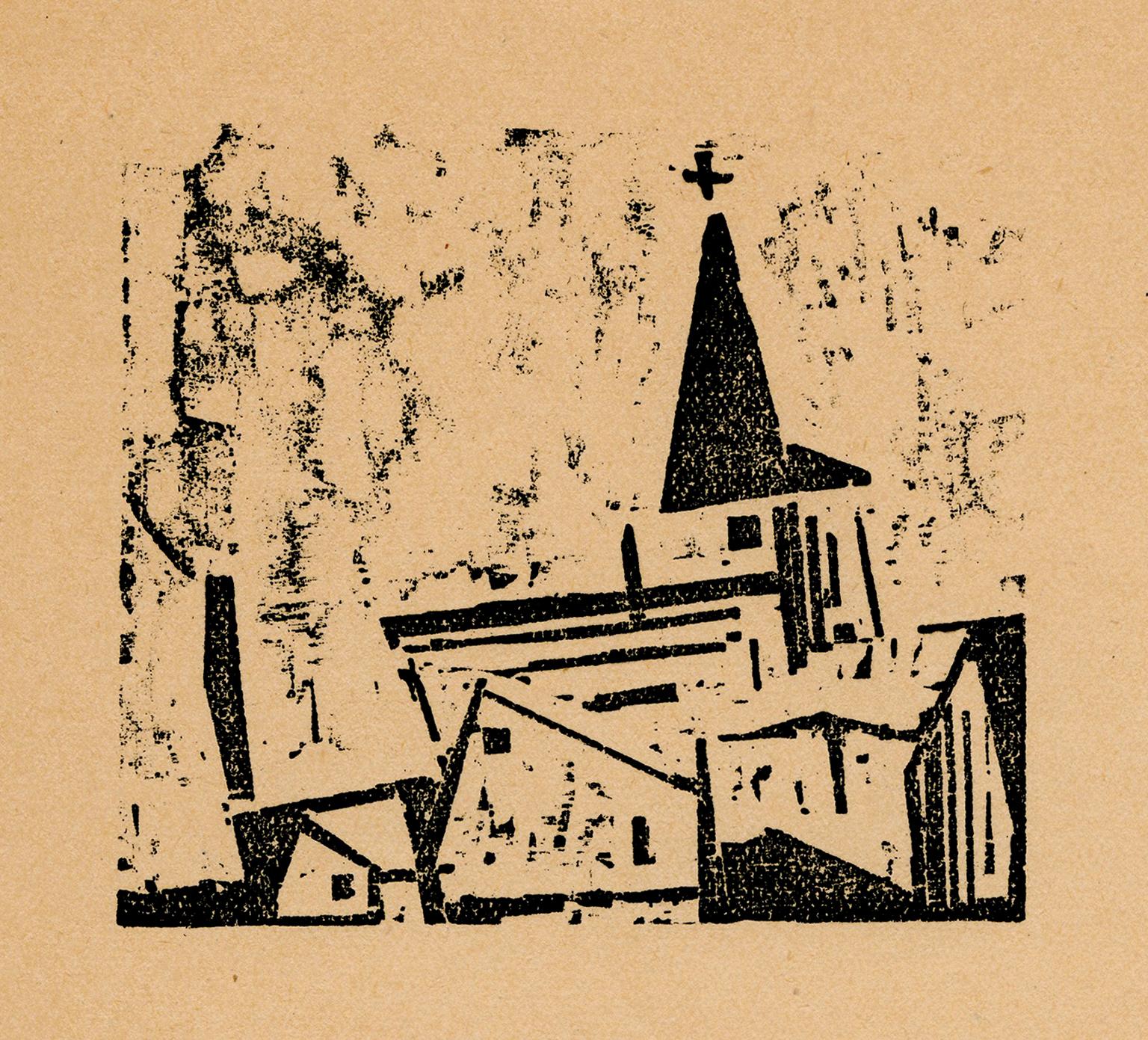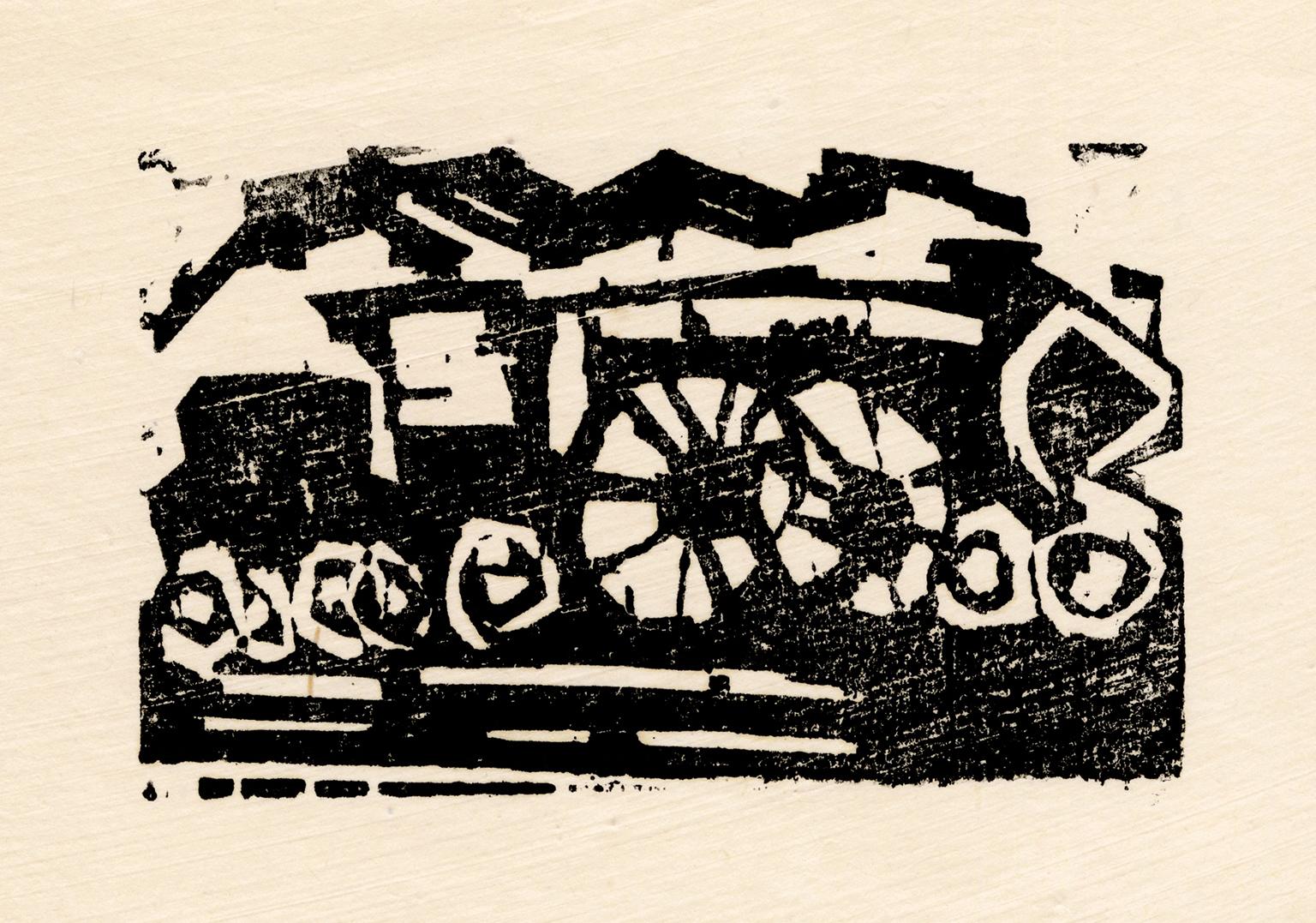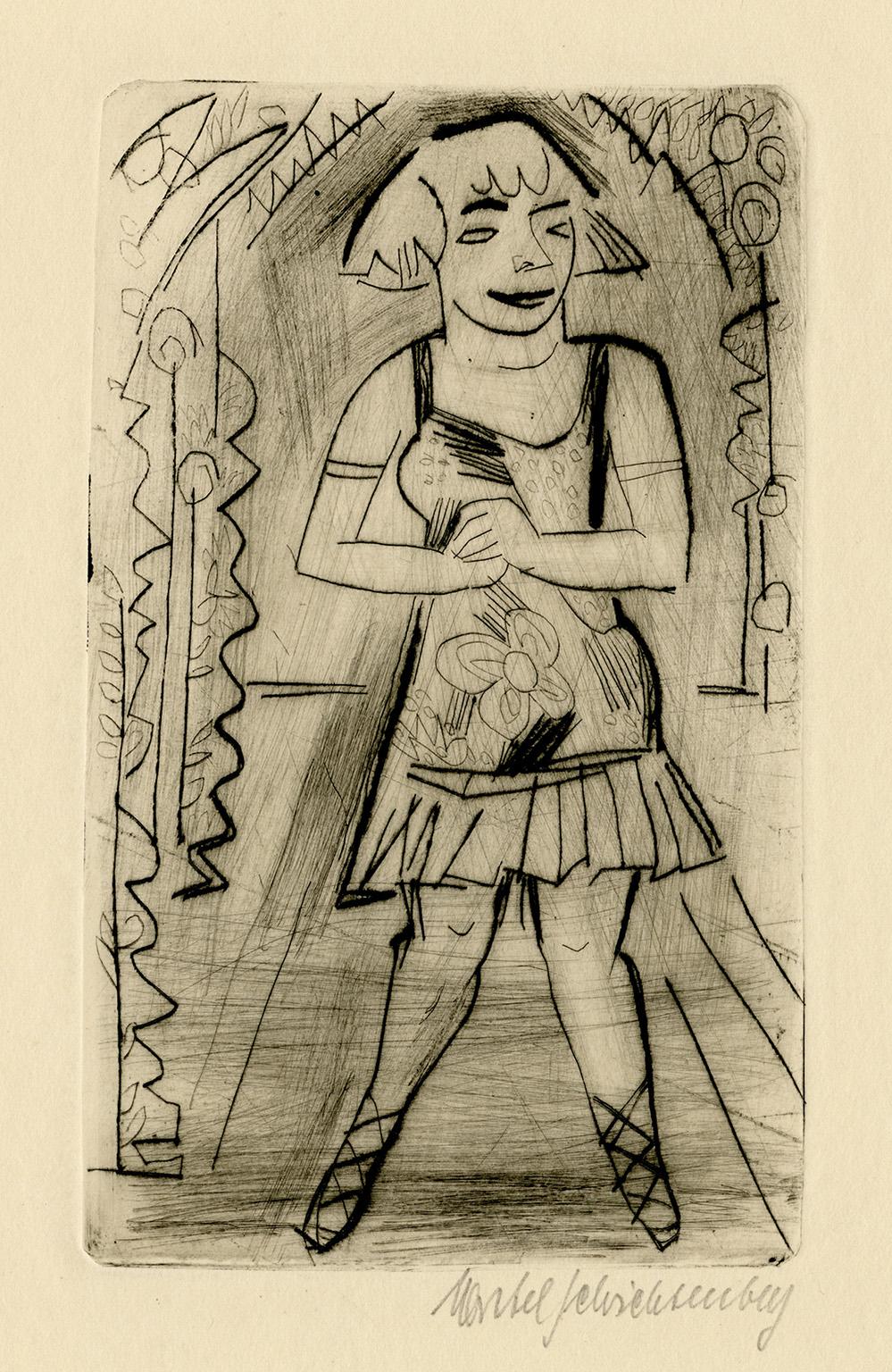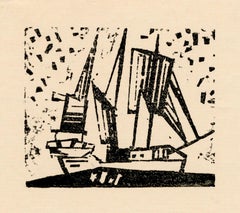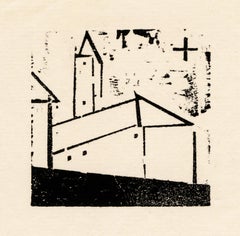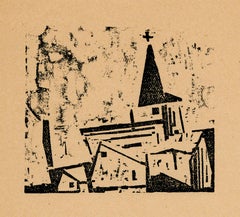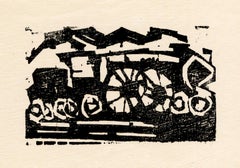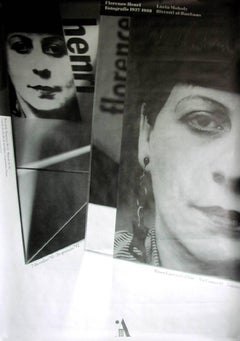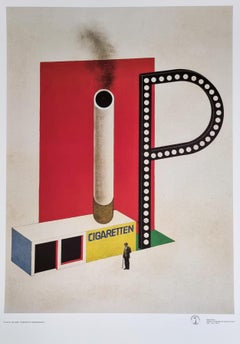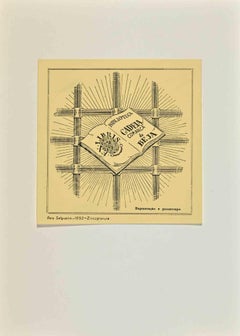Items Similar to 'Ausfahrender Dampfer Odin (Outboard Steamer Odin)' — German Expressionism
Want more images or videos?
Request additional images or videos from the seller
1 of 3
Lyonel Feininger'Ausfahrender Dampfer Odin (Outboard Steamer Odin)' — German Expressionism1918
1918
About the Item
Lyonel Feininger, 'Ausfahrender Dampfer Odin (Outboard Steamer Odin)', woodcut, 1918, proofs only. Prasse W75. Signed in pencil and annotated '1860', the artist’s inventory number. A fine, richly-inked impression on fibrous cream wove Japan paper, the full sheet with margins (1 1/2 to 1 7/8 inches), in excellent condition. A very scarce proof impression, printed by the artist.
Image size 3 3/16 x 4 7/16 inches (81 x 113 mm); sheet size 6 1/4 x 8 1/4 inches (159 x 210 mm). Matted to museum standards, unframed.
Collection: Staatliche Kunstsammlungen Dresden.
ABOUT THE ARTIST
Lyonel Feininger (1871-1956) was born in New York City into a German-American family of musicians—his father was a violinist and composer, and his mother was a singer and pianist. He studied violin with his father, and he was performing in public by the age of 12. However, he was also passionate about art and sketched incessantly, most notably the steamboats and sailing ships on the Hudson and East Rivers and the landscape around Sharon, Conn., where he spent time on a farm owned by a family friend. At 16, he traveled to Germany to pursue a music career, but being more attracted to art, he began studying drawing at the Kunstgewerbeschule in Hamburg. From 1888 to 1892, he attended the Akademie der Künste, Berlin, and worked as a caricaturist for magazines both in the US (Harper’s Round Table) and Germany (Fliegende Blätter), his innovative creations bringing him great success. In 1906-07, while staying in Paris, he worked for the French satirical weekly Le Témoin and published the weekly comic strip 'The Kin-Der-Kids' in the Chicago Sunday Tribune, the largest circulation newspaper in the Midwestern United States. He invented what became the standard design for the comic strip: in the words of editor Jon Carlin, "an overall pattern... that allowed the page to be read both as a series of elements one after the other, like language and as a group of juxtaposed images, like visual art."
Upon his return to Berlin in 1907, Feininger turned to easel paintings and drawings depicting architectural subjects and street scenes. After encountering Cubism and the works of Robert Delaunay during a 1911 trip to Paris, he began developing his distinctive lyrical style inspired by Cubist and Expressionist idioms and elevated by his resonance with the emotive qualities of light and color.
In 1913, at the invitation of the German Expressionists’ group Der Blaue Reiter, which had been founded in 1911 by Wassily Kandinsky and Franz Marc, he participated in the Erster Deutscher Herbstsalon at Herwarth Walden’s Der Sturm gallery in Berlin, where he also had his first solo exhibition in 1917. A year after his solo exhibition, in 1918, Feininger began making woodcuts. He became deeply absorbed in the printmaking process, producing 117 in his first year of exploring the medium. In 1919, at the invitation of the architect-founder Walter Gropius, he was appointed the first ‘form master’ at the newly formed and now renowned Staatliches Bauhaus in Weimar. His woodcut of a cathedral crowned by three stars illustrated the cover of the Bauhaus Manifesto. The dramatic image integrates elements of Cubism, Futurism, Expressionism, and Constructivism in a new artistic structure—a consummate avant-garde vernacular, yet one which used traditional sacred architecture as a template and symbolized “the new structure of the future,” with the alignment of the diverse avant-garde factions working in the name of a shared artistic and social cause which Gropius celebrated in the brochure’s manifesto. Feininger also published a portfolio of 12 woodcuts plus a title page, which has the distinction of being the renowned school’s first publication. While in Weimar, Feininger also worked on paintings whose structural order reflects the organizational principles of classical architecture and that of his own musical compositions wherein prismatic planes form dynamic constructions to produce a sense of energetic monumentality.
In 1924 Feininger founded the Die Blaue Vier (The Blue Four) group with his long-time friends and colleagues Wassily Kandinsky, Paul Klee, and Alexej Jawlensky. The group’s first exhibition in 1925 at the Charles Daniel Gallery in New York was followed by numerous other shows in Germany and the US. After the Bauhaus moved to Dessau in 1925, Feininger gave up teaching but remained an artist-in-residence and published another portfolio of 10 woodcuts—by that time, he had created 256 woodcuts.
In 1931, Feininger was given a major solo exhibition at the Nationalgalerie in Berlin, and from 1929 to 1931, he worked on a series of paintings of the city of Halle (Saale). In 1935, the National Socialists (Nazis) declared his art “degenerate.” As the Nazis gained power, Feininger and his wife, Julia, determined that life in Germany was untenable. In 1937, after nearly 50 years in the country, he and his family left for the United States to eventually settle back in New York.
In 1942, Feininger received a purchase prize from The Metropolitan Museum of Art, New York. Two years later, he was granted a retrospective with Marsden Hartley at The Museum of Modern Art, New York. The following year, in 1945, Josef Albers invited him to teach a summer course at Black Mountain College in North Carolina.
Feininger died on January 13, 1956, in New York.
The Lyonel Feininger Museum in Saxony-Anhalt, Germany, was established in 1986 to permanently honor the major artistic contributions of Lyonel Feininger to 20th-century classical modernism. The museum hosts a permanent exhibition of the artist's multi-faceted work, including caricatures, graphics, painting, photography, and Bauhaus master.
Posthumous retrospective exhibitions of his work have been held at the Dallas Museum for Contemporary Arts (1963), Pasadena Art Museum, California (1966), Kunsthaus Zürich (1973), and Whitney Museum of American Art, New York (2011). The J. Paul Getty Museum in Los Angeles organized the first exhibition of his photographs in 2011.
Feininger's works are held in numerous museum collections throughout the United States and Europe, including The Art Institute of Chicago; Achenbach Foundation for Graphic Arts (San Francisco); British Museum; Cincinnati Public Library; Cleveland Museum of Art; Deutsche Bucherel (Leipzig, Germany); Fogg Art Museum (Harvard University); Kester-Museum (Hanover, Germany); Kunstmuseum (Basel, Switzerland); Kunstmuseum der Stadt Dusseldorf (Dusseldorf, Germany); Los Angeles County Museum of Art; Museum Folkwang (Essen, Germany); Museum of Modern Art; Pennsylvania Academy of Fine Arts; Philadelphia Museum of Art; Saarland-Museum (Saarbrucken, Germany); Staatliche Kunsthalle (Karlsruhe, Germany); Staatliche Kunstsammlungen (Dresden, Germany); Stadtmuseum (Ludwigshafen am Rhein, Germany); Stiftung Preussischer Kulturbesitz Staatliche Museen (Berlin, Germany); The University of Nebraska Art Galleries (Lincoln, Nebraska); Yale University Art Gallery; and the Victoria and Albert Museum (London).
- Creator:Lyonel Feininger (1871-1956, American)
- Creation Year:1918
- Dimensions:Height: 3.19 in (8.11 cm)Width: 4.44 in (11.28 cm)
- Medium:
- Movement & Style:
- Period:
- Condition:
- Gallery Location:Myrtle Beach, SC
- Reference Number:Seller: 1042061stDibs: LU532312589172
About the Seller
5.0
Recognized Seller
These prestigious sellers are industry leaders and represent the highest echelon for item quality and design.
Platinum Seller
Premium sellers with a 4.7+ rating and 24-hour response times
Established in 1995
1stDibs seller since 2016
297 sales on 1stDibs
Typical response time: 1 hour
Associations
International Fine Print Dealers Association
- ShippingRetrieving quote...Shipping from: Myrtle Beach, SC
- Return Policy
Authenticity Guarantee
In the unlikely event there’s an issue with an item’s authenticity, contact us within 1 year for a full refund. DetailsMoney-Back Guarantee
If your item is not as described, is damaged in transit, or does not arrive, contact us within 7 days for a full refund. Details24-Hour Cancellation
You have a 24-hour grace period in which to reconsider your purchase, with no questions asked.Vetted Professional Sellers
Our world-class sellers must adhere to strict standards for service and quality, maintaining the integrity of our listings.Price-Match Guarantee
If you find that a seller listed the same item for a lower price elsewhere, we’ll match it.Trusted Global Delivery
Our best-in-class carrier network provides specialized shipping options worldwide, including custom delivery.More From This Seller
View All'Three Masted Ship, 2' – Artist's Personal Letterhead, Bauhaus Modernism
By Lyonel Feininger
Located in Myrtle Beach, SC
Lyonel Feininger, 'Three Masted Ship, 2 (Dreimastiges Schiff, 2)', woodcut, 1937, one of a small but unknown number of letterhead proofs; Prasse W296. Feininger estate stamp and inventory no. 'W 865' in pencil, bottom left sheet corner. Annotated 'W 296' and 'on block : 3702a' in pencil, bottom right sheet corner.
A fine impression, on cream, laid, letterhead stock; hinge remains on the left and right top sheet edges, verso, in excellent condition. Very scarce.
Image size 2 1/4 x 2 11/16 inches; sheet size 10 x 6 3/4 inches. Archivally sleeved, unmatted.
Exhibited: 'Lyonel Feininer, Woodcuts Used As Letterheads'; Associated American Artists; Feb 4 - March 2, 1974; New York, NY.
ABOUT THE ARTIST
Lyonel Feininger (1871-1956) was born in New York City into a musical family—his father was a violinist and composer, his mother was a singer and pianist. He studied violin with his father, and by the age of 12, he was performing in public, but he also drew incessantly, most notably the steamboats and sailing ships on the Hudson and East Rivers, and the landscape around Sharon, Conn., where he spent time on a farm owned by a family friend. At the age of 16 he left New York to study music and art in Germany, from where his parents emigrated. Drawn more to the visual arts, he attended schools in Hamburg, Berlin, and Paris from 1887 to 1892.
After completing his studies, Feininger began his artistic career as a cartoonist and illustrator, his originality leading him to great success. In 1906, after working for a dozen years in Germany, he was offered a job as a cartoonist at the Chicago Tribune, the largest circulation newspaper in the Midwest. He worked there for a year, inventing what became the standard design for the comic strip: in the words of John Carlin, “an overall pattern. . . that allowed the page to be read both as a series of elements one after the other, like language and as a group of juxtaposed images, like visual art.” His originality did not end there: he went on to become one of the great abstract painters. Like Kandinsky, music was his model, but Kandinsky only knew music from the outside—as a listener (inspired initially by Wagner, then by Schoenberg)—while Feininger knew it from the inside. He lived in Paris from 1906 to 1908, during which time he met and was influenced by the work of progressive painters Robert Delaunay and Jules Pascin, as well as that of Paul Cezanne and Vincent van Gogh. He began painting full-time, developing his distinctive Iyrical style based on Cubist and Expressionist idioms and a concern for the emotive qualities of light and color. He exhibited with the Der Blaue Reiter group in 1913, and in 1917, he had his first solo exhibition at Galerie Der Sturm in Berlin.
One year after his solo exhibition, in 1918, Feininger began making woodcuts. He became enamored with the medium, producing an impressive 117 in his first year of exploring the printmaking medium. In 1919 at the invitation of the architect Walter Gropius, he was appointed the first master at the newly formed Staatliches Bauhaus in Weimar. His woodcut of a cathedral crowned...
Category
1930s Bauhaus Figurative Prints
Materials
Woodcut
'Church with Star' – Artist's Personal Letterhead, Bauhaus Modernism
By Lyonel Feininger
Located in Myrtle Beach, SC
Lyonel Feininger, 'Church with Star (Kirche mit Stern)', woodcut, 1936, one of a small but unknown number of letterhead proofs; Prasse W265. Annotated 'W 265' (Feininger catalogue number) and inventory no. '2808' in pencil, in the bottom right sheet corner. A fine impression, on cream, laid letterhead stock; hinge remains on the left and right top sheet edges, verso, in excellent condition. Very scarce.
Image size 2 3/8 x 2 3/8 inches; sheet size 10 1/16 x 7 1/16 inches. Archivally sleeved, unmatted.
ABOUT THE ARTIST
Lyonel Feininger (1871-1956) was born in New York City into a musical family—his father was a violinist and composer, his mother was a singer and pianist. He studied violin with his father, and by the age of 12, he was performing in public, but he also drew incessantly, most notably the steamboats and sailing ships on the Hudson and East Rivers, and the landscape around Sharon, Conn., where he spent time on a farm owned by a family friend. At the age of 16 he left New York to study music and art in Germany, from where his parents emigrated. Drawn more to the visual arts, he attended schools in Hamburg, Berlin, and Paris from 1887 to 1892.
After completing his studies, Feininger began his artistic career as a cartoonist and illustrator, his originality leading him to great success. In 1906, after working for a dozen years in Germany, he was offered a job as a cartoonist at the Chicago Tribune, the largest circulation newspaper in the Midwest. He worked there for a year, inventing what became the standard design for the comic strip: in the words of John Carlin, “an overall pattern. . . that allowed the page to be read both as a series of elements one after the other, like language and as a group of juxtaposed images, like visual art.” His originality did not end there: he went on to become one of the great abstract painters. Like Kandinsky, music was his model, but Kandinsky only knew music from the outside—as a listener (inspired initially by Wagner, then by Schoenberg)—while Feininger knew it from the inside. He lived in Paris from 1906 to 1908, during which time he met and was influenced by the work of progressive painters Robert Delaunay and Jules Pascin, as well as that of Paul Cezanne and Vincent van Gogh. He began painting full-time, developing his distinctive Iyrical style based on Cubist and Expressionist idioms and a concern for the emotive qualities of light and color. He exhibited with the Der Blaue Reiter group in 1913, and in 1917, he had his first solo exhibition at Galerie Der Sturm in Berlin.
One year after his solo exhibition, in 1918, Feininger began making woodcuts. He became enamored with the medium, producing an impressive 117 in his first year of exploring the printmaking medium. In 1919 at the invitation of the architect Walter Gropius, he was appointed the first master at the newly formed Staatliches Bauhaus in Weimar. His woodcut of a cathedral crowned...
Category
1930s Bauhaus Figurative Prints
Materials
Woodcut
'Church with House and Tree' – Artist's Personal Letterhead, 1940s Modernism
By Lyonel Feininger
Located in Myrtle Beach, SC
Lyonel Feininger, 'Church with House and Tree (Kirche mit Haus und Baum)', woodcut, 1936, one of a small but unknown number of letterhead proofs; Prasse W290 IV. Annotated 'PW 290 state IV / IV 3669', in pencil, in the bottom right sheet corner. With the artist's typed address and date adjacent to the letterhead image: 'Falls Village, Connecticut September 26th, 1940'.
A fine impression, on buff, wove letterhead stock; several small losses, and tears, in the sheet edges (not affecting the image area); a crease in the bottom right sheet edge, otherwise in good condition. Very scarce.
Image size: 2 3/8 x 2 3/4 inches; sheet size 11 x 8 5/8 inches. Archivally sleeved, unmatted.
Feininger moved from Germany to New York City in 1938 and began spending his summers in Falls Village in 1940.
Exhibited: 'Lyonel Feininer, Woodcuts Used As Letterheads'; Associated American Artists; Feb 4 - March 2, 1974; New York, NY.
ABOUT THE ARTIST
Lyonel Feininger (1871-1956) was born in New York City into a musical family—his father was a violinist and composer, his mother was a singer and pianist. He studied violin with his father, and by the age of 12, he was performing in public, but he also drew incessantly, most notably the steamboats and sailing ships on the Hudson and East Rivers, and the landscape around Sharon, Conn., where he spent time on a farm owned by a family friend. At the age of 16 he left New York to study music and art in Germany, from where his parents emigrated. Drawn more to the visual arts, he attended schools in Hamburg, Berlin, and Paris from 1887 to 1892.
After completing his studies, Feininger began his artistic career as a cartoonist and illustrator, his originality leading him to great success. In 1906, after working for a dozen years in Germany, he was offered a job as a cartoonist at the Chicago Tribune, the largest circulation newspaper in the Midwest. He worked there for a year, inventing what became the standard design for the comic strip: in the words of John Carlin, “an overall pattern. . . that allowed the page to be read both as a series of elements one after the other, like language and as a group of juxtaposed images, like visual art.” His originality did not end there: he went on to become one of the great abstract painters. Like Kandinsky, music was his model, but Kandinsky only knew music from the outside—as a listener (inspired initially by Wagner, then by Schoenberg)—while Feininger knew it from the inside. He lived in Paris from 1906 to 1908, during which time he met and was influenced by the work of progressive painters Robert Delaunay and Jules Pascin, as well as that of Paul Cezanne and Vincent van Gogh. He began painting full-time, developing his distinctive Iyrical style based on Cubist and Expressionist idioms and a concern for the emotive qualities of light and color. He exhibited with the Der Blaue Reiter group in 1913, and in 1917, he had his first solo exhibition at Galerie Der Sturm in Berlin.
One year after his solo exhibition, in 1918, Feininger began making woodcuts. He became enamored with the medium, producing an impressive 117 in his first year of exploring the printmaking medium. In 1919 at the invitation of the architect Walter Gropius, he was appointed the first master at the newly formed Staatliches Bauhaus in Weimar. His woodcut of a cathedral crowned...
Category
1930s Bauhaus Figurative Prints
Materials
Woodcut
'Little Locomotive' – Artist's Personal Letterhead, Bauhaus Modernism
By Lyonel Feininger
Located in Myrtle Beach, SC
Lyonel Feininger, 'Little Locomotive (Kleine Lokomotive)', woodcut, 1936, one of a small but unknown number of letterhead proofs; Prasse W158. Annotated 'W 158' (Feininger catalogue number) and '1936' in pencil, in the bottom right sheet corner.
A fine impression, on cream, laid letterhead stock; hinge remains on the left and right top sheet edges, verso, in excellent condition. Very scarce.
Image size 2 1/4 x 3 5/16 inches; sheet size 10 x 7 inches. Archivally sleeved, unmatted.
Exhibited: 'Lyonel Feininer, Woodcuts Used As Letterheads'; Associated American Artists; Feb 4 - March 2, 1974; New York, NY.
Collections: Cleveland Museum of Art, Museum of Modern Art, Staatliche Museen zu Berlin (East Berlin KK).
ABOUT THE ARTIST
Lyonel Feininger (1871-1956) was born in New York City into a musical family—his father was a violinist and composer, his mother was a singer and pianist. He studied violin with his father, and by the age of 12, he was performing in public, but he also drew incessantly, most notably the steamboats and sailing ships on the Hudson and East Rivers, and the landscape around Sharon, Conn., where he spent time on a farm owned by a family friend. At the age of 16 he left New York to study music and art in Germany, from where his parents emigrated. Drawn more to the visual arts, he attended schools in Hamburg, Berlin, and Paris from 1887 to 1892.
After completing his studies, Feininger began his artistic career as a cartoonist and illustrator, his originality leading him to great success. In 1906, after working for a dozen years in Germany, he was offered a job as a cartoonist at the Chicago Tribune, the largest circulation newspaper in the Midwest. He worked there for a year, inventing what became the standard design for the comic strip: in the words of John Carlin, “an overall pattern. . . that allowed the page to be read both as a series of elements one after the other, like language and as a group of juxtaposed images, like visual art.” His originality did not end there: he went on to become one of the great abstract painters. Like Kandinsky, music was his model, but Kandinsky only knew music from the outside—as a listener (inspired initially by Wagner, then by Schoenberg)—while Feininger knew it from the inside. He lived in Paris from 1906 to 1908, during which time he met and was influenced by the work of progressive painters Robert Delaunay and Jules Pascin, as well as that of Paul Cezanne and Vincent van Gogh. He began painting full-time, developing his distinctive Iyrical style based on Cubist and Expressionist idioms and a concern for the emotive qualities of light and color. He exhibited with the Der Blaue Reiter group in 1913, and in 1917, he had his first solo exhibition at Galerie Der Sturm in Berlin.
One year after his solo exhibition, in 1918, Feininger began making woodcuts. He became enamored with the medium, producing an impressive 117 in his first year of exploring the printmaking medium. In 1919 at the invitation of the architect Walter Gropius, he was appointed the first master at the newly formed Staatliches Bauhaus in Weimar. His woodcut of a cathedral crowned...
Category
1930s Bauhaus Figurative Prints
Materials
Woodcut
'Church with House and Tree' – Artist's Personal Letterhead, Bauhaus Modernism
By Lyonel Feininger
Located in Myrtle Beach, SC
Lyonel Feininger, 'Church with House and Tree (Kirche mit Haus und Baum)', woodcut, 1936, one of a small but unknown number of letterhead proofs; Prasse W290 V. Inscribed 'J. F. note paper', in pencil, in the artist’s hand; with the Feininger estate stamp and catalog no. 'W 859' in pencil. Annotated 'W.290 V state 3609' in pencil, in the bottom right sheet corner.
A fine impression, on cream, laid letterhead stock; hinge remains on the left and right top sheet edges, verso, in excellent condition. Very scarce.
Image size 2 3/8 x 2 3/4 inches; sheet size 10 x 7 5/16 inches. Archivally sleeved, unmatted.
Exhibited: 'Lyonel Feininer, Woodcuts Used As Letterheads'; Associated American Artists; Feb 4 - March 2, 1974; NY, NY.
ABOUT THE ARTIST
Lyonel Feininger (1871-1956) was born in New York City into a musical family—his father was a violinist and composer, his mother was a singer and pianist. He studied violin with his father, and by the age of 12, he was performing in public. Still, he also drew incessantly, most notably the steamboats and sailing ships on the Hudson and East Rivers, and the landscape around Sharon, Conn., where he spent time on a farm owned by a family friend. At the age of 16 he left New York to study music and art in Germany, from where his parents emigrated. Drawn more to the visual arts, he attended schools in Hamburg, Berlin, and Paris from 1887 to 1892.
After completing his studies, Feininger began his artistic career as a cartoonist and illustrator, his originality leading him to great success. In 1906, after working for a dozen years in Germany, he was offered a job as a cartoonist at the Chicago Tribune, the largest circulation newspaper in the Midwest. He worked there for a year, inventing what became the standard design for the comic strip: in the words of John Carlin, “an overall pattern. . . that allowed the page to be read both as a series of elements one after the other, like language and as a group of juxtaposed images, like visual art.” His originality did not end there: he went on to become one of the great abstract painters. Like Kandinsky, music was his model, but Kandinsky only knew music from the outside—as a listener (inspired initially by Wagner, then by Schoenberg)—while Feininger knew it from the inside. He lived in Paris from 1906 to 1908, during which time he met and was influenced by the work of progressive painters Robert Delaunay and Jules Pascin, as well as that of Paul Cezanne and Vincent van Gogh. He began painting full-time, developing his distinctive Iyrical style based on Cubist and Expressionist idioms and a concern for the emotive qualities of light and color. He exhibited with the Der Blaue Reiter group in 1913, and in 1917, he had his first solo exhibition at Galerie Der Sturm in Berlin.
One year after his solo exhibition, in 1918, Feininger began making woodcuts. He became enamored with the medium, producing an impressive 117 in his first year of exploring the printmaking medium. In 1919 at the invitation of the architect Walter Gropius, he was appointed the first master at the newly formed Staatliches Bauhaus in Weimar. His woodcut of a cathedral crowned...
Category
1930s Bauhaus Figurative Prints
Materials
Woodcut
'Varietesoubrette, Schwalbennest' also Dancer — 1920s German Expressionism
Located in Myrtle Beach, SC
Martel Schwichtenberg (1896-1945), 'Varietésoubrette, Schwalbennest (Variety Soubrette, Swallow’s Nest), drypoint, 1922. Signed in pencil. A fine, richly-inked impression; the full sheet of cream wove paper, with wide margins (3 3/4 to 5 1/4 inches), in excellent condition. Image size 7 3/16 x 4 5/16 inches; sheet size 16 3/8 x 12 1/8 inches. Archivally matted to museum standards, unframed.
Published in Die Schaffenden...
Category
1920s Bauhaus Figurative Prints
Materials
Drypoint
You May Also Like
BENDIX ALUFROID original horizontal French poster
Located in Spokane, WA
Original Herve Movan vintage French poster: BENDIX ALUFROID.
Horizontal format size: 43" wide by 30.5.
Professional acid-free archival linen backed, very good condition; ready to ...
Category
1960s Bauhaus Figurative Prints
Materials
Lithograph
$796 Sale Price
20% Off
Florence Henri
By Bruno Monzuzzi
Located in New York, NY
Ritratti al Bauhaus. Photo-offset poster.
Museo cantonale d'arte Lugano
Year: 1991.
Monguzzi studied in Geneva and London, spent part of his early career in at the studio of Antonio Boggeri, in Milan. The inspiration of the experimental and visually-daring work of the avant garde designers Herbert Bayer, El Lissitsky, Jan Tschichold, Piet Zwart, Paul Schuitema, Ladislav Sutnar...
Category
1990s Bauhaus Figurative Prints
Materials
Offset
Sale and Marketing Kiosk for P Cigarettes (Bauhaus) (20% OFF + Free Shipping)
By Herbert Bayer
Located in Kansas City, MO
Herbert Bayer
Sale and Marketing Kiosk for P Cigarettes (Verkauf- und Werbekiosk, Zigarettenmarke P ), 1924
Offset Lithograph
Year: 1994
Size: 33.2 × 23.2 inches
Publisher: Bauhaus A...
Category
1920s Bauhaus Prints and Multiples
Materials
Lithograph
$120 Sale Price
20% Off
Ex Libris Biblioteca Cadeia Comarca de Beja - Woodcut Print - Mid-20th Century
Located in Roma, IT
Ex Libris Biblioteca Cadeia Comarca de Beja is an Artwork, woodcut print on paper. The work is glued on cardboard.
Total dimensions: 21 x 15.5 cm.
The artwork represents an elegan...
Category
Mid-20th Century Symbolist Figurative Prints
Materials
Woodcut
Artist Mother 1967 Signed Limited Edition Woodblock
By Philip Sutton
Located in Rochester Hills, MI
Philip Sutton
Artist Mother - 1967
Print - Woodcut 29'' x 24.25''
Edition: signed and numbered in pencil 7/25
Image Size; 18"x 18"
Condition Note; Handling Creases.
Philip Sutton s...
Category
1960s Figurative Prints
Materials
Linocut, Woodcut
$600 Sale Price
20% Off
Ex Libris Matea Serra - Woodcut Print - Mid-20th Century
Located in Roma, IT
Ex Libris Matea Serra is an Artwork, woodcut print on ivory-colored paper. The work is glued on cardboard.
Total dimensions: 21 x 15.5 cm.
The artwork represents a daily scene, thr...
Category
Mid-20th Century Symbolist Figurative Prints
Materials
Woodcut
